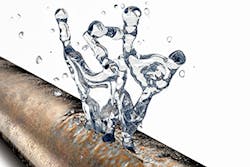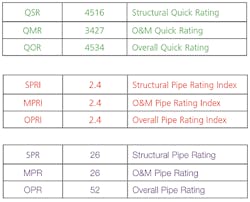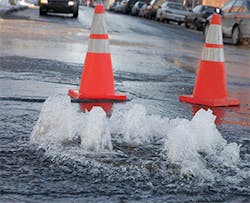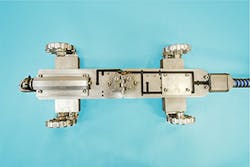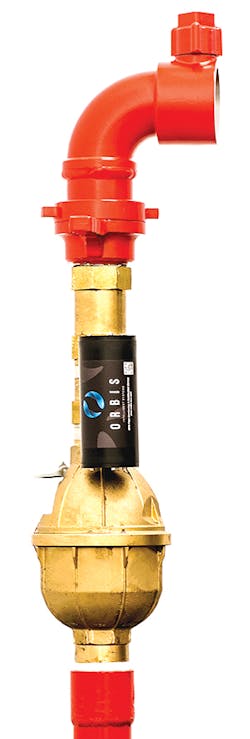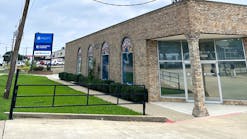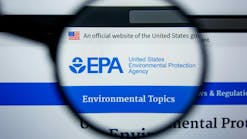Never has it been more important to inspect and maintain hydraulic infrastructure. Never has it been harder in both remote rural areas and crowded urban environments to do so. Direct inspection of pipes and sewers is essentially impossible given the small diameter sizes of the pipes in question. Yet aging infrastructure is more prone than ever to damage and in need of repair. Fortunately, the technology for remote pipe inspection with closed-circuit television (CCTV) camera crawlers or submersible remotely operated vehicles (ROV) provides a cost-effective solution. Inserting these camera-mounted vehicles at a pipe opening and running them along its length while digitally recording what they see through the camera lens eliminates the need for costly excavation to expose the pipe while detecting.
Furthermore, this operation quickly identifies and locates problems, allowing for preventive repair operations, and flags those minor defects that could be become major problems in the future. This nondestructive inspection method is fast, precise, environmentally friendly, and easy to operate. It includes software for comprehensive data recording to explain the video images, allowing for accurate reporting on the condition of the pipes being inspected.
NASSCO AND PACP, MACP, AND LACP CERTIFICATION
A technology needs well-established and universally recognized methodology and usage rules. These have been established for pipe inspections by the National Association of Sewer Service Companies (NASSCO). They have committed themselves to “setting industry for the assessment, maintenance, and rehabilitation of underground infrastructure, and to assure the continued acceptance and growth of trenchless technologies.” In doing so they created, in partnership with the United Kingdom’s Water Research Center (WRC), the Pipeline Assessment and Certification Program (PACP) which has become the industry standard in North America for identifying pipeline defects, assessing the condition of pipelines, standardizing inspection methods, and establishing consistent scoring procedures.
The result of the PACP program is to establish a comprehensive and standardized database to evaluate pipeline conditions and manage pipeline repair efforts. It does not just create a unified system of coding, it also establishes a Code of Ethics as outlined by NASSCO for Certified Operator’s to follow. Similar programs were established by NASSCO for a Manhole Assessment and Certification Program (MACP) and a Lateral Assessment and Certification Program (LACP).
THE PACP SCORING AND RATING SYSTEM
Before we examine the various types of structural failures or operational and maintenance defects, we need to understand the scoring system that is used to rate the condition of the pipes. These scores are referred to as “condition grades” and are rated in two categories: structural or operations and maintenance. Scoring is on a numerical scale with the highest (5) denoting the worst conditions and the lowest (1) designating minor defects—and zero indicating no defects at all:
5 – Most significant defect
4 – Significant defect
3 – Moderate defect
2 – Minor to moderate defect
1 – Minor defect
0 – No defect
Naturally, this rating system is somewhat subjective. A lot depends on the training, experience, competence, and skill of the technician doing the inspection. Furthermore, the depth and quality of the water within the pipe may obscure the pipe wall, preventing the camera from providing a clear image. Inspectors need to double-check each other’s evaluations and often have to work together to come up with a consensus on the pipe scoring. This is why PACP training and certification of the technicians performing the pipe inspections (or its equivalent) is absolutely necessary for accurate pipe appraisals.
But not every defect is a point defect. Some can extend for considerable distances along the length of the pipe or around its circumference. These can include cracks and fissures in the pipe wall or entire sections of crushed pipe. The PACP system has a simple and elegant way of converting these elongated defects into an equivalent number of point defects. This number of converted point defects is calculated by dividing the length of the defect by 5 feet (or 1.5 meters for the metric system) with the result rounded to the nearest whole number. For example, a 32-foot-long longitudinal crack would be the equivalent of 6 each point defects (32/5 = 6.4).
Tallying up the scores of the individual pipe defects results in a pipe rating. Rather, there are three different kinds of ratings; Quick Rating, Overall Pipe Rating, and Pipe Rating Index. The basic Segment Grade score is calculated by summing up the multiple of the number of each defect grades (1 through 5) by the number of each category of defect. For example, a pipe with 8 each grade-5 structural defects and 4 each grade-3 operational and maintenance defects would have 40 for the pipe’s structure and 12 for its O&M.
The pipe’s Quick Rating is a kind of shorthand describing the worst defects present in the pipe. It is a four-digit number that lists the highest and next highest severity grades followed by the number of times each of these graded defects occurs. For example, a pipe segment with a Quick Rating of 5236 would have the equivalent of 2 each defects with a severity grade of 5 (worst) and 6 each defects with a severity grade of 3 (moderate). A pipe with zero defects would have a Quick Rating of 0000. For those types of defects that number more than 9 each, letters are used to designate their quantity in increments of 5 (A = 10 to 14, B = 14 to 19, C = 20 to 34, etc.). So, a pipe with a Quick Rating of 4F2K would have 35 to 39 category 4 defects and 60 to 64 category 2 defects. The Quick Rating does not include any reference to defects in categories lower than the worst two. So, the above examples could represent pipes with the equivalent of 100 each category 1 defects, but these would not be reflected in the Quick Rating.
The Overall Pipe Rating is a grand total of all the pipe segment scores, both point defects and equivalent linear defects, for structural and operations and maintenance. There are separate Overall Pipe ratings for structural defects and operational and maintenance defects. Caution should be exercised when using the Overall Pipe rating to evaluate a pipe since it can include a large number of low-grade defects, while only a few high-grade defects are required to endanger the pipe.
The Pipe Rating Index solves this problem by indicating the overall severity of the pipe’s defects. The Pipe Rating Index is calculated by dividing the Overall Pipe rating by the number of actual defects (both point defects and the equivalent number of lengthy defects). The result is an average of the Segment Grades and gives an indication of the overall severity of the pipe defects but without indicating the actual number of defects or whether the severity is high or low.
The table on the previous page provides a summary example of these pipe evaluation calculations.
The tabulated calculations result in an overall quick rating for the pipe of 4534 with a Structural Quick Rating of 4516 and an O&M Quick rating of 3427. With a structural pipe rating of 26 and an O&M pipe rating of 26, the total Overall Pipe Rating is 52. Similarly, these result in Pipe Rating Indexes of 2.4 for both the overall score as well as the structural and O&M ratings.
These ratings are assigned to pipe segments rather than the entire pipeline. Pipe segments are defined as sections of pipe between manholes, outlets, or other structures. So, a storm sewer with a length of one mile, consisting of 10 segments, each starting and ending at a manhole inlet structure, and ending with an outlet discharge at a local creek, would receive 10 ratings, one for each pipe segment. This eliminates the need to arbitrarily designate a length of pipeline for the purpose of inspection ratings and it distinguishes those segments that may have significant defects from those that have minor defects or none at all—instead of lumping unlike segments all together.
PACP STRUCTURAL STANDARDS AND SCORING
Pipe inspections are performed to discover any defects that could impair a pipe’s structural soundness or ability to transport water. What sort of structural defects are we looking for? What could go wrong? Structural defect codes established by the PACP include the following:
- Crack
- Fracture
- Broken
- Hole
- Deformed
- Collapsed
- Joint Displaced
- Surface Damage
- Lining Feature Damage
- Weld Failure
- Point Repair
- Brick Work
Each type of defect comes in several varieties. Cracks and fractures can be longitudinal, circumferential, multiple, or spiral. Broken pipe or pipe with a hole can reveal soil or empty space outside of its walls. Deformed conditions can exist in both rigid and flexible pipe and include creasing of the wall or the pipe taking on an elliptical shape. Collapse is complete failure of the pipe wall, whereas joint displace is localized and small, medium, or large. Damage can occur to both the original pipe wall and subsequently installed lining in place. These can include spalling and delamination. Failed welds and previously patched and repaired pipes count as structural defects. For old-fashioned sewers constructed from brick, missing or displaced bricks constitute a structural defect.
In general, the scoring assigned to each type and sub-type of defect depends on its inherent severity and potential danger to the pipe’s structural integrity. That is why a damaged or missing pipe wall would rate as a 5, while an increase in pipe wall roughness rates only as a 4. Rating also changes with location depending on whether the pipe is installed as part of a standard storm or sanitary sewer system running under streets or in a more critical location passing through an earthen dam or levee. A pipe in poor condition can cause potentially catastrophic failure via pipes and seepage through the soil or the earthwork. So, a medium joint separation in a sewer would rate only a score of a moderate 3, whereas the same defect in a levee would rate as a worst case 5.
PACP OPERATIONS AND MANAGEMENT STANDARDS AND SCORING
Operational and maintenance defects do not directly threaten the pipe’s structural integrity, but they can negatively impact its operation and performance. As with structural standards, operations and maintenance standards include multiple defect codes:
- Deposits and Encrustations – these are accumulations of various types of waste materials (grease, ragging, fines, gravel, etc.). Deposits accumulate on the pipe bottom while encrustations cling to the pipe wall up to the surface water elevation within the pipe.
- Roots from adjacent trees can enter a pipeline from various locations (connections, tap joint, etc.).
- Infiltration consists of soil and water entering the pipe from the outside through a defect and can appear as a stain, weeping, drips, or a gusher.
- Obstructions/Obstacles can include fallen brick and masonry, split off pipe material, construction debris, and rocks. It can be found on the pipe floor or wedged into a joint by an external pipe or cable.
- Vermin – basically evidence of rat infestations as well as insects (spider, cockroaches), and yes—even the occasional alligator in the sewer.
- Grout Test Locations – site of failed grout or grout applications.
- Taps into the Pipe Sidewall – these are constructed breaches in the pipe wall to allow for the insertion of branch pipelines, spigots, valves, pipe saddles, etc.
- Intruding Seal Material – each joint is typically sealed with a ring or material. In this case, the sealing material has failed and come loose from the joint.
- Alignment Changes – these are designed and constructed changes in pipeline alignment (towards the left, right, up or down) that occur outside of a manhole.
- Access Points – similar to taps, they allow for connections to clean outs, discharge points, pipe end caps, catch basins, etc.
- Miscellaneous – is a catchall for conditions that obscure camera observation, like the flooding of the pipe with murky water to a depth where the camera cannot see clearly, water accumulated in areas where the pipe has sagged, and the point where a survey is abandoned.
PIPE SCORING AND RISK MANAGEMENT
At the end of the day, inspecting and rating pipes is all about risk management, specifically minimizing risk. And this risk is evaluated by estimating two factors: the likelihood of failure and the consequences of failure.
The likelihood of failure is based on the pipe’s Quick Rating. So, the likelihood of failure is calculated by dividing the first two numbers of the quick rating by 10. Again, the first number is the pipe’s highest defect category. In the example above the first two numbers are 45 (for 5 each defects rated as category 4). Dividing this number by 10 gives us a Likelihood of Failure of 4.5. If the last number is a letter, it is replaced by 0 and 1.0 is added to the result of the division. So, a 5C would have a Likelihood of Failure of 6.0
The Consequences of Failure is a more broad-based analysis. It factors in potential social costs (impact on society and properties such as hospitals, schools, parks, etc.), economic costs (direct and indirect costs to the owner and third parties for resultant damages and subsequent repair work), and environmental costs (negative impacts on environmental assets, and post damage resource extraction). These, in turn, are rated according to the pipelines location and local demographics. Factors assigned to the calculation of the Consequences of Failure are based on pipe diameter, pipe depth below surface grade, location of the pipe segment within the pipe network, location near various types of roadways, nearby environmentally sensitive features, number of customers serviced by the pipeline, and ease of accessibility for maintenance and inspection.
Aquam’s Amplus ROV pipe inspection technology
The Likelihood of Failure is cross-indexed to the Consequences of Failure to form a two-axis space with the x-axis measuring likelihood and the y-axis measuring consequences. The higher the likelihood of failure, the more aggressive the rehabilitation effort needs to be. The higher the consequences of failure, the more aggressive the inspection regime has to be.
CCTV CRAWLER AND SUBMERSIBLE ROV TECHNOLOGY
A CCTV crawler is a form of telepresence, no different than the sophisticated submersible that found the HMS Titanic on the ocean floor. It allows for the human operator to establish a remote presence in an inhospitable environment along the entire length of the pipeline while providing a perfect digital memory in the form of video recordings and data entry. And it is not just limited to use in pipelines that are too small for humans to enter. The inspection of even a pipeline large enough for a man to stand up in can benefit from technology because of this superior safety, ease of use, and quality provided by CCTV crawlers. The video recording of the pipe’s interior can be considered a form of non-destructive testing in that nothing is disturbed or dislocated in the process of evaluating the condition of the pipe.
The CCTV crawler is delivered to the pipeline site by a service truck, which also contains all of the system’s electronic controls and recording technology. Equipped with a small generator, it also provides an electrical power source for the crawler and its support equipment. The crawler is connected and anchored to the service truck with a wire cable deployed from a winch. The winch plays out the cable as the crawler moves forward under its own power (either on wheels or tractor treads) until it reaches the end of the pipe or the limit of the inspection. When the inspection has been completed, the cable is then reeled in, bringing the crawler back to its point of entry. The camera is mounted to the body of the crawler on a swivel head that allows it to look in a 360-degree arc to the sides and 180-degree arc towards the front of the camera. It is equipped with LED lights and is connected via a signal cable back the truck’s recording equipment. Some cameras come with sonar for measuring pipe wall thickness or lasers to perform accurate measurements. The location of the camera as it moves along the pipe is measured by the amount of cable deployed by the winch.
The unfortunate thing about pipelines is that they are often partially, or completely, filled with water. If only a certain percentage of the pipe has water, a CCTV crawler can still be used, though it may have trouble seeing what lies under the water’s surface. For pipes completely filled with water, a floating submersible ROV is typically used. Though similar in function and basic components as a CCTV crawler (front-mounted camera, LED lights for illumination, towing cable, signal wire, etc.), it’s basically a small submarine, with adjustable ballast tanks for changing depth and propellers for movement and maneuvering. Since the submersible can easily adjust its orientation and depth, its camera is typically not mounted on a swivel head since the whole ROV can effectively swivel while moving.
The critical elements of any pipeline inspection (dry or submerged) include proper control of online data collection systems, accurate location and measurement to ensure that defects are correctly accounted for, a means of reporting defects, and the correct maintenance and storage of the inspection data.
Aquam’s Orbis Intelligent Systems for real-time remote monitoring of water and other infrastructure assets
MAJOR SUPPLIERS
To meet the need for innovative new pipe technology, Pearpoint went back to the basics. They asked themselves, what innovative new pipe inspection technologies are available? The pipe inspection industry has a simple requirement, with a very complex response. New technology is not always the answer for a clear, complete picture of the pipe with enough clarity to identify defects. This being said, the company has created a system that will go the length of the inspection in a timely fashion, while giving the operator the tools to record defects properly with accurate footage information. New technology on the market that helped advance inspection thoroughness follows. In the last 10 years to 15 years Pierpont has added several tools to the arsenal of the CCTV inspection operator. Laser Profiling allows the camera a reference to record the ovality of the pipe being inspected. Sonar offers the ability to see inside pipes that hold water and cannot easily be drained. The biggest advances have been on the inspection standard side of the industry with guidelines being put in place to standardize what operators see and code in the pipe.
That being said, there is the Pearpoint P350 pipe inspection system. Pearpoint uses an optical counter, making it one of the most accurate on the market. This allows the operator the comfort of knowing the footage he records is going to be solid information for reporting the location for repairs. The system uses LED lights, giving the surrounding environment ample illumination for a quality inspection of defects and lateral connections into the main pipe. Pearpoint also uses low LUX cameras tuned to the light output used in the pipe. This allows for a crisp, clear, color-correct image of the interior. The Pearpoint system also has an active interface with some of the largest asset management software packages on the market. This allows the images, footage, inclination or grade, and the ovality recorded in the pipe to be stored and transferred in a standard easily used by most engineers, contractors, and system owners
Pearpoint supports water conservation and asset management. As Pearpoint spokesperson Whitney Williams states, “The PACP standard by NASSCO has helped with this, as well as guidelines installed by the government, making it mandatory to record issues like SSO’s and offering resources to system owners helping them deal with antiquated and combined sewer systems. The more accurate the equipment that records the errors, the more proficient the planned repair should be. The industry is making a move to apply the baseline standards used for sanitary sewer upkeep and diagnostics to its aging storm sewer infrastructure in the future. I feel this is driven by the knowledge that clean water is an asset that has been overlooked for a long time, especially around the great lake regions where it is so plentiful.” What is defined as a “passing grade” for a pipe inspection? “I think if we answered this by saying, a system with proper grade, no infiltration, no offset joints, no structural defects, everyone would agree. The problem comes in with the system owner’s resources. A large community may make a 1.2-million-dollar repair to a piping system without a problem, where a Township might be forced to perform a band-aid-style repair as a triage reaction because of limited resources.”
Any differences between pipelines passing through dikes and dams versus standard sewer or supply pipe installations? According to Williams, “The placement of the pipe system always gives unique challenges to an operator. A pipe in a casing through a damn wall would have different concerns than an aerial sewer or a direct bury sewer. A cased pipe would be harder to access for a certain type of repair than a pipe buried 7 feet in the ground. A buried pipe might have other utilities in the way; electric, water, gas.” And which are more critical, structural defects or O&M issues? “This question will go down in history as, as easy to answer as which came first, the chicken or the egg. This depends on an almost endless supply of criteria. To each system owner, the answer would be different. One owner might find infiltration during a rain event to be the downfall of the system. The next one might have the treatment of the water for free release to be his biggest concern.”
Aquam Corporation, a global water and gas infrastructure firm, has launched Amplus, the most advanced remote operated vehicle (ROV) on the market. It is their most innovative pipe inspection technology launched to date. Designed for use in pressurized water, wastewater, and industrial pipe applications, Amplus was created in response to a need from cities across the US struggling to address the challenges associated with an old and aging infrastructure. At the core, Amplus’ strength empowers cities to strategically plan for the future by offering a comprehensive assessment of the condition of their pipeline infrastructure and producing actionable data to prioritize capital expenditure and improve overall system reliability.
Ultrasonic technology, coupled with HD CCTV and acoustic sensors, can determine pipe wall thickness, identify internal and external corrosion, calculate life expectancy, provide high-resolution visual video footage, and accurately locate leaks in real time. The system is inserted into live pipelines 8 inches and above through existing system assets causing no disruptions to service and has a 3300-foot inspection capability upstream and downstream of the insertion point. With Aquam’s Amplus, clients can get a deeper understanding of the overall health of their linear assets and make defensible remediation decisions regarding repair, replacement, and rehabilitation, enabling them to allocate funds intelligently. Amplus is set to be deployed by Aquam service providers with commercial, residential, utility, and municipal customers in the US and UK effective within the summer of 2018.
Aquam’s global team designs novel technologies that solve some of the most challenging infra and external structure problems safely, ethically, affordably, unobtrusively, and sustainably. Risks are largely mitigated through a three-step process: monitor, repair, and remediate the transmission and distribution of water and wastewater pipelines. The award-winning approach provides a combination of actionable data utilizing key performance indicators to ascertain the overall condition of pipes, such as leakage, pipe wall thickness, internal and external diameters, and visual intelligence.
Emma Quail, VP at Aquam Pipe Diagnostics sales and marketing, promotes preventative methodologies and technologies for condition assessment, pipeline diagnostics, and non-revenue water (NRW) assessment and reduction in the US. According to Emma Quail, “My passion continues to be about increasing awareness of sustainability and conservation of one of our most precious resources. Therefore, I am proud to be at the forefront of a progressive and innovative company who are committed to offering quality services and advancements in pipeline assessment technologies. As a volunteer on the AWWA Water Loss Control Committee and a contributing author of the new M77 Manual of Practice: Condition Assessment of Water Mains, I am proud to play an active role in the water and wastewater industry here in the US.”
Aquam’s technology is also uniquely qualified to handle aging and iconic structures. For example, in the aftermath of Hurricane Sandy, when many of the historic buildings in New York City suffered damage to their pipes, roofs, and drains. St. Thomas Episcopal Church—an iconic west side Manhattan cathedral completed in 1914 and an institution for Gothic Revival architecture—is one of those buildings. Buried behind layers of stone in hard-to-reach areas of the wall, the church’s pipes were clogged with dirt and sediment. Water leaked from the pipes and threatened to damage parts of the wall in the church’s sanctuary. Utilizing non-invasive diagnostic and remediation procedures, Nu Flow, a subsidiary for Aquam Corporation, successfully assessed the problem with a specialized camera and coated the corroding pipes with an epoxy liner to prevent further damage and leakage into the wall.
Angel Estrada, St. Thomas facilities manager touches on the experience: “After being the facilities manager for more than 30 years, the challenges of this building still surprise me. Once I eventually realized that the pipes could be rehabilitated in a matter of weeks, and without disturbing the church’s regular worship services, I wondered why we had waited so long to tackle the seemingly impossible task. I believe in innovation, which is why my biggest takeaway coming out of the experience was to keep an open mind about partnering with private sector entities and out of town specialists.”
